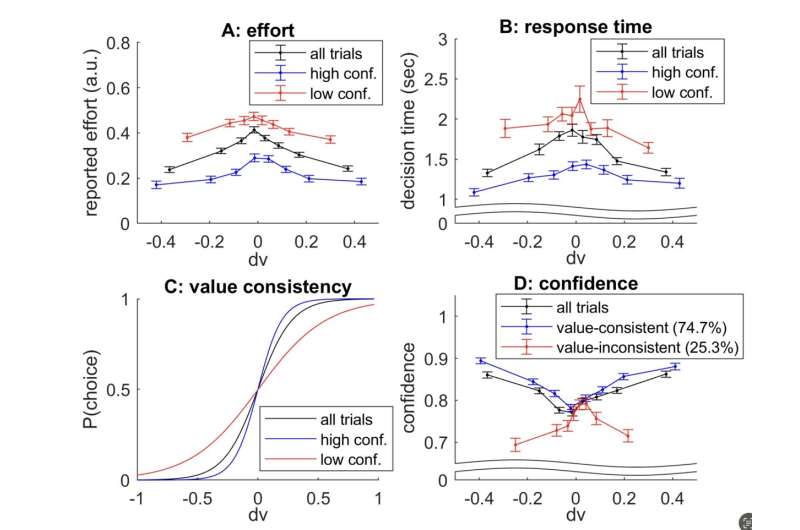May 14, 2024 feature
This article has been reviewed according to Science X's editorial process and policies. Editors have highlighted the following attributes while ensuring the content's credibility:
fact-checked
trusted source
proofread
A minimal cognitive architecture reproduces control of human decision-making processes

Neuroscientists and psychologists have been trying to pinpoint the processes behind human decision-making for decades. While their efforts led to numerous interesting insights, the intricacies of complex decision-making remain poorly understood.
Researchers at the Paris Brain Institute carried out a study aimed at better understanding how the human brain allocates its resources when making decisions. Their paper, published in Communications Psychology, introduces an architecture that operates the online metacognitive control of decisions (oMCD), a theoretical construct describing why and how the brain choses to stop of continue deliberating.
Past studies have found that humans do not always invest their maximum mental efforts when making decisions. This can lead to various widely documented errors and cognitive biases (i.e., recurring deviations from rational thinking).
"The question behind our study is: when making a decision, what determines the amount of mental effort we invest in decisions?" Jean Daunizeau, co-author of the paper, told Medical Xpress.
"Previous behavioral research suggested that, for certain kinds of decisions (so-called 'evidence-based' decisions), this may be done by balancing decision confidence (which tends to increase with mental effort) with the cost of mental effort. This then triggered the question: can this work for all kinds of decisions?"
To address this question, researchers should first demonstrate that a confidence-based control policy eventually yields mental effort investments resembling those of optimal control policies that are specific to different kinds of decisions. This was one of the primary objectives of the work by Daunizeau and her colleagues.
"We approach this problem in many different ways," Daunizeau explained. "In the context of this study, we effectively provided two lines of evidence. The first one is theoretical in essence. Specifically, we rely on so-called Markov Decision Processes (MDPs) to demonstrate that confidence-based control policies are quasi-optimal for a broad class of decisions."
After having identified the non-trivial quantitative properties of confidence-based control policies, the researchers set out to determine whether these properties can be found in empirical data gathered in experiments where humans completed decision-making tasks. The properties they specifically sought for included three-way interactions between the values of different options, decision times and the reported confidence in a decision.
"In brief, we identified a minimal cognitive architecture for quasi-optimal decision control (in terms of how much effort is invested)," Daunizeau said. "Importantly, this architecture may generalize over most, if not all, kinds of decision types. This implies that a single brain system may operate decision control, irrespective of the type of decision."
The paper by Daunizeau and her collaborators could pave the way for further neuroscientific studies testing this hypothesis, potentially shedding new light on the underpinnings of human decision-making.
"In our next studies, we will try to identify the neural basis of decision control," Daunizeau added. "This will involve a reanalysis of existing neuroimaging and electrophysiological data acquired during various decision tasks, as well as designing novel neuroscientific experiments."
More information: Juliette Bénon et al, The online metacognitive control of decisions, Communications Psychology (2024). DOI: 10.1038/s44271-024-00071-y.
© 2024 Science X Network



















